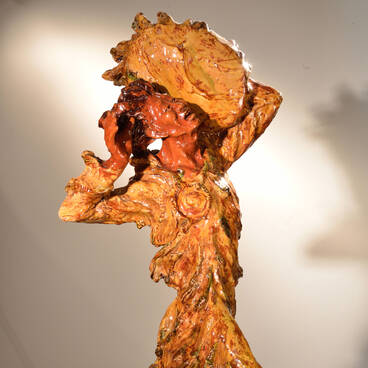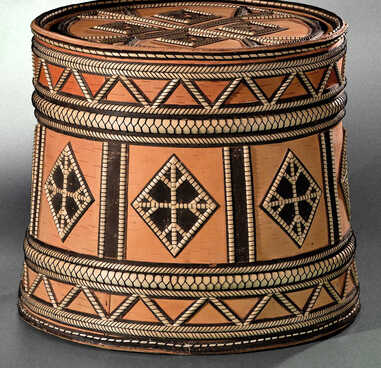In traditional Yakut families young girls lived in separate quarters (‘happakhchi’), where no strangers were allowed. Happakhchi aana (Yakut) is a wooden screen that was placed at the entrance to the room of an unmarried woman in order to separate her from the rest of the house.
The name of such a screen is derived from the Yakut word ‘happakh’, which means ‘cover’. This screen from the collection of the National Fine Arts Museum of the Republic of Sakha (Yakutia) was made by Yelizaveta Olesova in 2015. In her works she makes use of ancient technologies and creates Yakut national fur clothing and various household utensils.
The door has a traditional trapezoidal shape with curved top corners. It consists of three birch bark layers, which are sewn together with horsehair. As a basis, the back side of the door is applied to the wood bark. The front layer of birch bark is laid with the light side, which is called ‘drawing’. On it, an ornamental applique is sewn: it is covered with black paint with drawings cut through the top. The screen pattern consists of parallel zigzag rows with rhombuses at the top. The top of the ornamental pattern carries diamond-shaped pieces with small carved circles, through which one can see the second, light-coloured layer of birch bark. Additionally, the master decorated the curtain with pendants made of beads and coins.
The birch bark art has been known in Yakutia since ancient times. This material became popular due to its flexibility and a pleasant light colour. ‘Elley gathered birch bark, put up sticks, tied them up at the top and covered them with bark decorated with patterns, cogs and clippings, thus forming an urasa, a house’, that is how the craft is described in the Yakut oral poems ‘Olonkho’, which appeared over a thousand years ago.
For a long time, birch bark products - screens, buckets, boxes, dishes - were made exclusively for domestic use. In the 20th century the situation changed: simple and practical things gave way to decorative pieces. Craftsmen began to decorate their works with geometric figures, images of plants or animals, beads and metal plates. To the present days birch bark artwork remains a popular craft in Yakutia.



